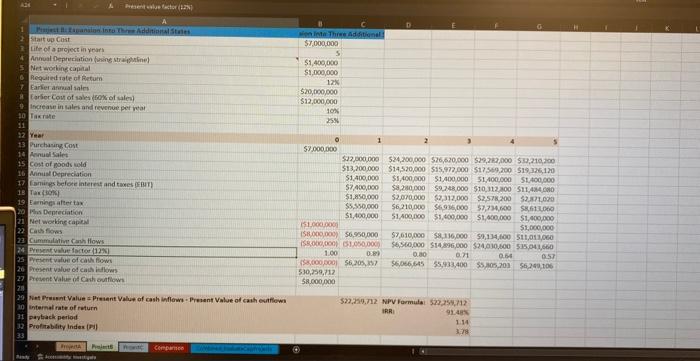Question
This assessment is about one of the basic functions of the finance manager, which is allocating capital to areas that will increase shareholder value and
This assessment is about one of the basic functions of the finance manager, which is allocating capital to areas that will increase shareholder value and add the most value to the company. This means forecasting the projected cash flows of the projects and employing capital budgeting metrics to determine which project, given the forecast cash flows, gives the firm the best chance to maximize shareholder value. As a finance professional, you are expected to:
- Use capital budgeting tools to compute future project cash flows and compare them to upfront costs.
- Evaluate capital projects and make appropriate decision recommendations.
- Prepare reports and present the evaluation in a way that finance and non-finance stakeholders can understand.
Scenario
Senior leadership has now called upon you to analyze three capital project requests based on forecasted cash flow as they relate to maximizing shareholder value.
Your Role
You are one of Maria's high-performing financial analyst managers at ABC Healthcare Corporation and she trusts your work and leadership. Senior leadership was impressed with your presentation in Assessment 1 and they are tasking you with the analysis of these three proposed capital projects based on forecasted cash flow. You have completed forecasting the projected cash flows of the projects as reflected in the attached spreadsheets, Projected Cash Flows [XLSX]. You now need to conduct your analysis recommending which will provide the most shareholder value to the organization.
Requirements
- Use capital budgeting tools to compute future project cash flows and compare them to upfront costs. Remember to only evaluate the incremental changes to cash flows.
- Employing capital budgeting metrics, to determine which project, given the forecast cash flows, gives the organization the best chance to maximize shareholder value.
- Demonstrate knowledge of a variety of capital budgeting tools including net present value (NPV), internal rate of return (IRR), payback period, and profitability index (PI). The analysis of the capital projects will need to be correctly computed and the resulting decisions rational.
- Evaluate capital projects and make appropriate decision recommendations. Accurately compare the indicated projects with correct computations of capital budgeting tools and then make rational decisions based on the findings.
- Select the best capital project, based on data analysis and evaluation, that will add the most value for the company. Provide a rationale for your recommendations based on your financial analysis.
- Prepare reports and present the evaluation in a way that finance and non-finance stakeholders can understand.
Project A: Major Equipment Purchase
- A new major equipment purchase will cost $10 million; however, it is projected to reduce the cost of sales by 5% per year for 8 years.
- The equipment is projected to be sold for a salvage value estimated to be $500,000 at the end of year 8.
- Being a relatively safe investment, the required rate of return of the project is 8%.
- The equipment will be depreciated at a MACRS 7-year schedule.
- Annual sales for year 1 are projected at $20 million and should stay the same per year for 8 years.
- Before this project, the cost of sales has been 60%.
- The marginal corporate tax rate is presumed to be 25%.
Project B: Expansion Into Three Additional States
- Expansion into three additional states has a forecast to increase sales/revenues and cost of sales by 10% per year for 5 years.
- Annual sales for the previous year were $20 million.
- Start-up costs are projected to be $7 million and an upfront needed investment in net working capital of $1 million. The working capital amount will be recouped at the end of year 5.
- The marginal corporate tax rate is presumed to be 25%.
- Being a risky investment, the required rate of return of the project is 12%.
Project C: Marketing/Advertising Campaign
- A major new marketing/advertising campaign, which will cost $2 million per year and last 6 years.
- It is forecast that the campaign will increase sales/revenues and costs of sales by 15% per year.
- Annual sales for the previous year were $20 million.
- The marginal corporate tax rate is presumed to be 25%.
- Being a moderate-risk investment, the required rate of return of the project is 10%.








Step by Step Solution
There are 3 Steps involved in it
Step: 1

Get Instant Access to Expert-Tailored Solutions
See step-by-step solutions with expert insights and AI powered tools for academic success
Step: 2

Step: 3

Ace Your Homework with AI
Get the answers you need in no time with our AI-driven, step-by-step assistance
Get Started


